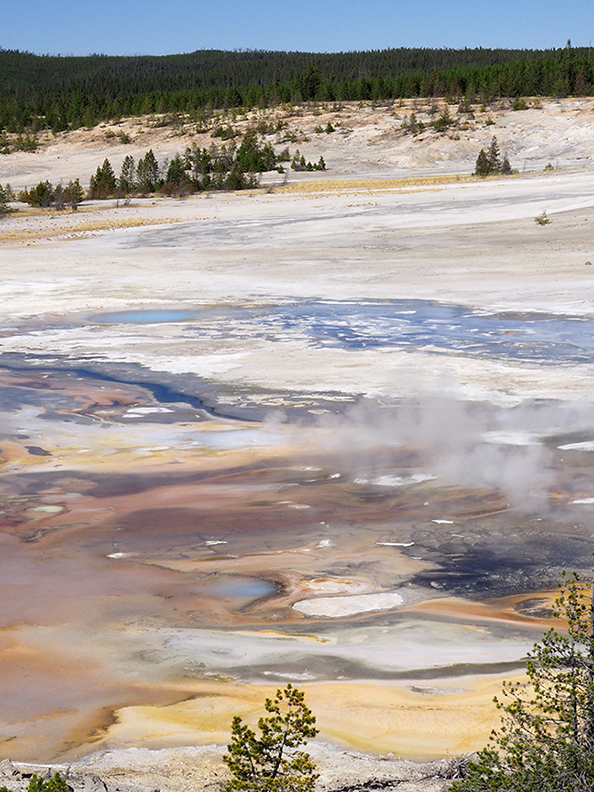When you’ve been away from a beautiful landscape, your memory loses some of the particulars of its beauty and changes others. That’s what I was thinking when I drove through the Lamar Valley (see last post). If Yellowstone had no geysers, no hot springs or mud pots or fumaroles—even if it had no elk and bison—it would still be a stunningly glorious place.
This day, however, I experienced another stunning aspect of Yellowstone: the sheer numbers of people. I knew it would be crowded, but I was astonished by just how crowded in was even in late September. The crowds included all sorts of people but were dominated by Japanese and, I think, Korean couples taking selfies at every pool, every geyser, every sign. Yet still I had a few moments by myself at Mammoth Hot Springs and at Porcelain Basin, part of the Norris Geyser Basin, literally the hottest spot in the park, with springs almost as hot as boiling, and highly acidic to boot.

Palette Spring, Lower Terrace, Mammoth Hot Springs

Dryad Spring, Upper Terrace, Mammoth Hot Springs

Dead tree and dead spring, Upper Terrace, Mammoth Hot Springs
The oranges and reds in these photos are created by communities of thermophiles (heat-loving bacteria); the greens are created by communities of cyanobacteria (also thermophiles, but a very different kind, commonly called blue-green algae). When the source of a spring changes and the spring dries up, these organisms die, and only the chalky whiteness of the travertine formations remains.
Porcelain Basin is my favorite place in Yellowstone because of the lovely colors, many of them pastel but some brilliantly vivid. The features here include not only hot springs and geysers but fumaroles—essentially, steam vents. A light spray from these vents misted my skin and hair as I walked down into the basin.

Fumaroles, Porcelain Basin

Hot springs, Porcelain Basin. The teal-blue comes, in part, from arsenic.

Cyanobacteria (blue-green algae) in runoff from a hot spring

One overview, Porcelain Basin
After Porcelain Basin, I drove through the Madison River valley to West Yellowstone to secure a hotel room for the night, then got to Old Faithful at dusk. I’ve seen this geyser on several previous trips, but never saw so many people waiting for it to erupt. It was fortunate that I wasn’t anxious to get a good photo of Old Faithful, because it was almost dark and both of the batteries for my Olympus were exhausted. At the moment the geyser started to erupt, hundreds of cell phones were lifted up simultaneously by the people in attendance. To an alien it would have resembled some bizarre worship ritual. Here’s one of my obligatory iPhone photos—color noise and all—to cap off this day.

Old Faithful at dusk








